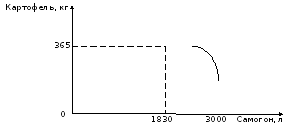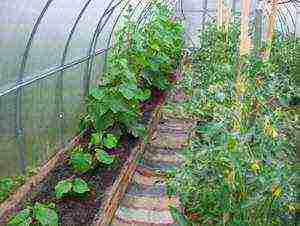Content
On the territory of the Russian Federation, more than 300 varieties of potatoes of domestic and foreign selection are approved for use. Such a variety is not easy to understand. Experts recommend, when selecting a variety, to pay attention to whether it is present in the State Register and whether it is recommended for your climatic zone. Consider which varieties in Siberia have proved to be the most reliable, abundant and delicious.
The best potato varieties for Siberia
Despite the fact that Siberia is not like the homeland of the vegetable - Bolivia - the culture feels great, annually showing high yields and delighting potato growers with an excellent taste and size of tubers. The climate and soil conditions of Siberia make it possible to grow almost any variety of early (50–65 days), medium early (70–75 days) and medium (80–95 days) potatoes. Late potatoes are not grown in Siberia, since the duration of the warm period in the region is insufficient for the full maturation of the tubers.
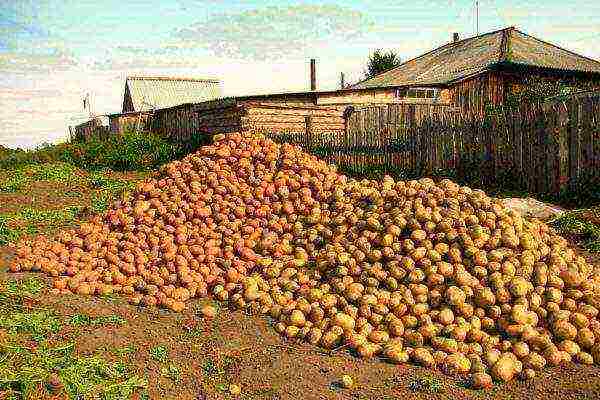
The climatic conditions of Siberia allow you to get a good harvest of potatoes
Soil and climatic conditions sometimes differ even within the same area, what can we say about land plots located at opposite ends of the region. It is even more difficult to choose the best potatoes for Siberia, a vast region stretching over 3 time zones. Which of the varieties to choose? You should not rely on new products if they are not already on the list of officially recommended varieties. When planning to replenish the assortment of potatoes on the site, choose the already well-known names.
Table: potatoes recommended for Siberian regions (for 2016)
As can be seen from the table, for each region of Siberia, you can choose good potatoes of both domestic and foreign selection. Usually gardeners grow on their site not one, but at least two or three varieties, trying to pick up tubers with different ripening periods.
Experienced owners say that the best potatoes are the ones that can grow specifically in your garden.
The most productive varieties
Siberia has a rather harsh climate. The region is characterized by frosts in late spring and early summer, droughts in May, intense heat in July and cold snaps in August. But even in such difficult weather conditions, some varieties have time to fully mature and give a yield of 400 or more centners / ha. Unfortunately, even with full adherence to agricultural technology, it is impossible to get a record number of tubers from a hundred square meters from mediocre varieties. To grow a large crop, you need to pay maximum attention to the choice of planting material.
The following varieties are distinguished by a high yield (40-50 t / ha):
- Uddlets - medium early, obtained at the Kemerovo Research Institute of Agriculture (Kemerovo).In this potato, the aerial part has a modest size, but rather large oval tubers, covered with a smooth yellow skin with very small eyes, are hidden under the tops. Average tuber weight - 250 g. Starch content - 12-16%, yield - 20-50 t / ha, in some years - 60 t / ha. The variety is not only fruitful, but also decaying - 94% of the harvested tubers remain until spring;
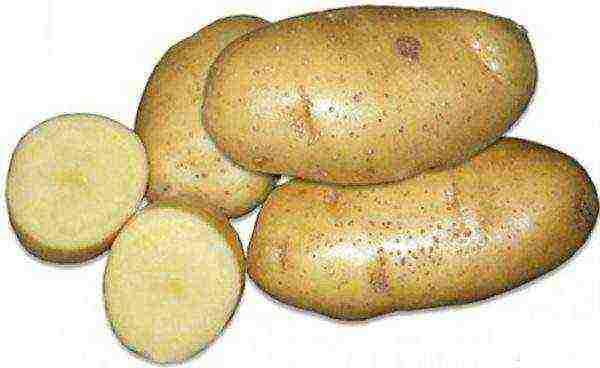
Udalets variety is characterized by high yield and excellent keeping quality.
- Nevsky;
- Sotochka.
The last two varieties will be discussed in more detail below.
Early potato varieties for Siberia
Early-ripening potatoes are less productive than autumn varieties, are stored worse and suffer more from diseases and pests. Early varieties are more demanding to care for than others. But all these disadvantages are paid off by obtaining fresh products in the shortest possible time.
The following early potato cultivars are popular in Siberia:
-
Priekulsky early (Latvian selection). The taste of this potato is satisfactory, the average tuber weight is 100 g. The first tubers can be dug out already on the 60th day after planting. In the conditions of Western and Eastern Siberia, after the complete withering away of the tops, the variety shows a yield of 350 centners per hectare. The tubers are oval, milky in color, the eyes are small, the skin is smooth, the flesh does not turn black when cut. The cultivar is strongly affected by late blight, but by the time the disease spreads massively, the crop usually has time to form.
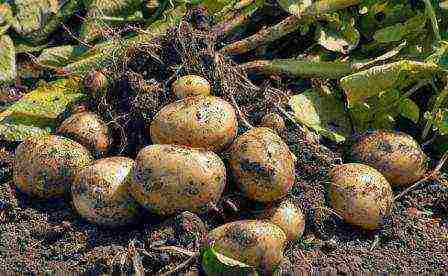
Variety Priekulsky early ("forty days") is a champion in early maturity in Siberia
-
Zhukovsky early. A table variety, bred in the Moscow region, is considered the standard for early potatoes. 2 months after planting, it gives up to 120 c / ha of marketable tubers, the yield during harvesting is 450 c / ha. The cultivar is resistant to nematodes, scab, rhizoctonia. The tops and tubers are moderately affected by late blight. The tubers are oval with small eyes, the skin is pink, smooth, the flesh is white. The tubers of this variety do not boil over. They are very tasty "in their uniforms", suitable for making salads, as after cooking they are easily cut into pieces.
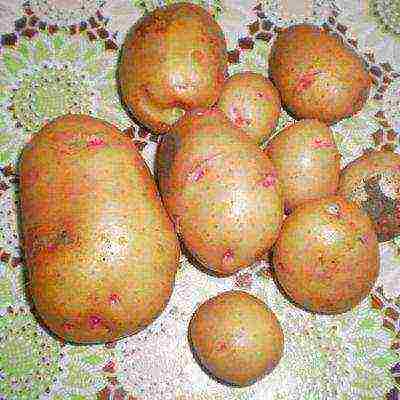
Zhukovsky early is recommended for the Tyumen region, but it is successfully grown in other Siberian regions.
-
Alena is a very popular variety in Siberia. It was bred in the Moscow region, but the patent for it was acquired by the Omsk SibNIISKhoz. The cultivar is recommended for growing in the Novosibirsk and Omsk regions. The average weight of tubers is 90–160 g. The color of the skin is red, the flesh is beige. The potato tastes good, is moderately soft, does not darken. The variety is excellent for preparing hot meals and processing into chips. Productivity - 170-200 centners / ha, in some years it reaches 400 centners per hectare. Potatoes can be dug up 60–70 days after germination. When harvesting tubers in the middle of the growing season (45-50 days), the Alena variety shows a yield of 150 centners per hectare. Potatoes are moderately resistant to viruses and late blight.
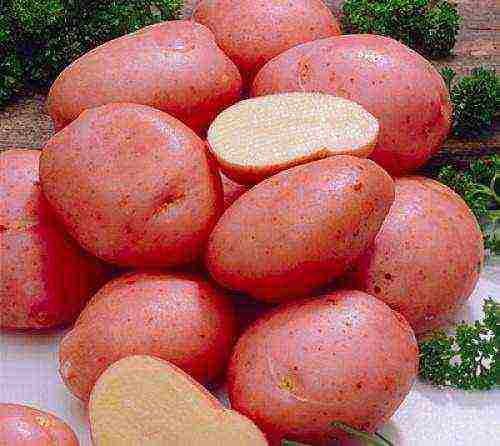
Alena's potatoes tolerate the absence of moisture and hot weather well, while ensuring a stable harvest
- Rosara is an early-maturing universal cultivar, bred in Germany. Ripens a week later than the first early varieties. The maximum yield is 415 c / ha. Rosara is resistant to cancer and nematodes, rarely affected by late blight and scab. It doesn't matter if the summer is dry or rainy - if you plant Rosara, you will not be left without a "second bread". At the same time, there is no need to frequently update the planting material, since the yield does not fall for 4–5 years. Rosara's tubers are oblong, leveled in size, well stored and perfectly tolerated during transportation. The skin is red, the flesh is yellowish. The average mass of potatoes is 80–120 g. Tuber crops contain about 15% starch, therefore they do not boil during cooking, but they have a good taste. Suitable for boiled dicing (for salads, vinaigrette), soups, frying and drying.

Rosara gives an excellent harvest regardless of weather conditions
Mid-early and mid-season potatoes for Siberia
In Siberia, mid-early and mid-season varieties are the basis of the harvest. They keep well and are therefore recommended for autumn and winter consumption. This group includes:
-
Svitanok Kiev is an old mid-early variety. Its main advantage is its outstanding taste characteristics. The starch content in the tubers reaches 19%, the potatoes are very soft, therefore ideal for making mashed potatoes. Svitanok Kiev is well stored, gives rather large tubers, the yield of the variety in Siberia is above average. Does not suffer from cancer, moderately resistant to late blight, can be affected by a nematode. The cultivar is recommended for cultivation in the Omsk, Tyumen and Novosibirsk regions.
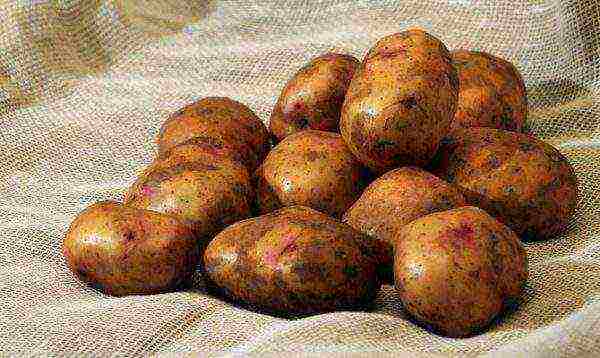
Svitanok Kiev potatoes are always popular due to their taste
-
Hostess. The variety was bred in the city of Tomsk (Siberian Research Institute of Agriculture and Peat), it is recommended for the regions of Novosibirsk and Krasnoyarsk. The average weight of a marketable tuber is 140 g, the maximum yield is more than 380 c / ha. Potatoes of this variety can be used to make mashed potatoes and crispy chips. In early spring, when the carbohydrate content in the tubers decreases after a long storage period, the Hostess becomes suitable for frying and cooking soups. The tubers are round, with a reddish skin and creamy flesh. The cultivar is resistant to cancer and nematodes.
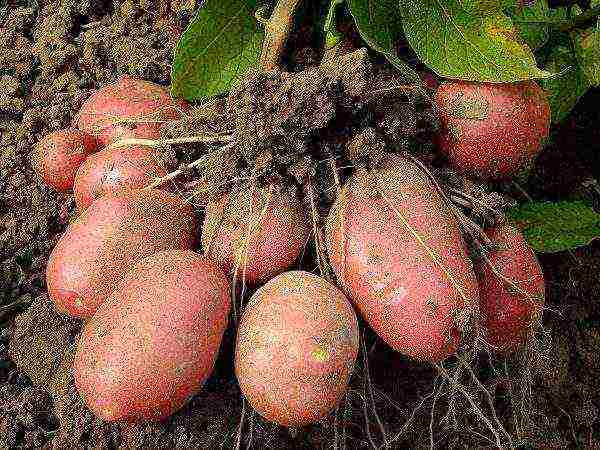
Hostess potato tubers contain a large amount of carbohydrates, so they have an excellent taste
-
Nevsky is a mid-early variety bred at the Vsevolzhskaya selection station in the seventies of the last century. Although many new varieties have now appeared that surpass Nevsky in yield, it is still recommended for cultivation in a number of regions of Russia, including Tomsk, Omsk, Novosibirsk, Irkutsk and Krasnoyarsk. The advantages of the variety are resistance to cancer, relative resistance to late blight. Nevsky is exceptionally harvestable, in different years it is possible to collect from 38 to 50 tons per hectare. Tubers ripen 80–95 days after germination. The average fruit weight is about 110 g. The tubers are oblong, with white pulp and thin yellow skin, covered with few small eyes. The cultivar is intended for dining purposes, the taste is satisfactory. Potatoes of this variety do not boil well, therefore they are of little use for mashed potatoes, but they can be used for soup, fried, and baked.
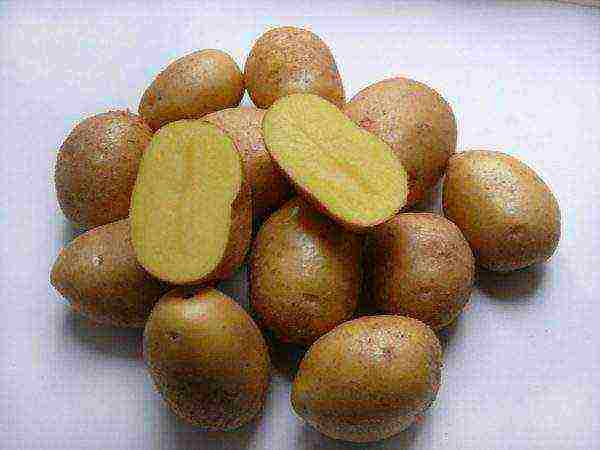
Nevsky is a champion in yield in Siberia
-
Adretta is a mid-early variety that is grown in all regions of Siberia, despite the fact that it has not been in Rosreestr for a long time. This potato is immune to cancer, rarely suffers from viral diseases, but is prone to late blight and scab. Round-oval tubers with a yellowish peel and pulp, weighing up to 150 g. Potatoes of this variety contain a lot of starch (up to 18%), therefore they boil quickly and are suitable for mashed potatoes. Productivity is high, keeping quality is satisfactory.

Adretta is appreciated for its taste, the puree from it turns out to be crumbly, of a beautiful yellow color
- Sante is a potato bred in the Far East. The variety is medium early, universal, gives a good harvest of marketable tubers, which lie for a long time in winter. Sante rarely suffers from cancer and potato nematodes, he is not afraid of late blight and viruses, but in some years he is strongly affected by scab and rhizoctonia. The tubers are large, oblong, covered with a yellow rind, under which the flesh of a yellowish tint is hidden.
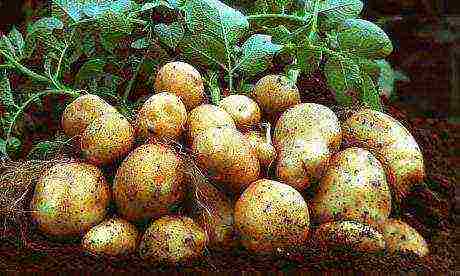
Variety Sante is very stable, recommended for cultivation in the Tomsk and Tyumen regions
Siberian varieties
In Siberia, breeders are engaged in the development of new varieties of potatoes, adapted to local climatic conditions. Among the new products, the following can be noted:
-
Epic of Siberia. In 2016, the cultivar was transferred for state variety testing. Potatoes are of medium ripening, capable of producing a high yield even in arid conditions. The pulp and skin are light. The tubers are suitable for frying, mashed potatoes, soups and crispy potatoes.
-
Triumph is an early ripe cultivar with light skin and pulp.It was bred in Omsk together with the SeDeK agricultural company, in 2017 it was submitted for testing. The new variety is highly marketable. Has shallow eyes and even tubers, even if the crop is grown on heavy lumpy soil. The amount of starch is medium, the pulp is slightly crumbly.
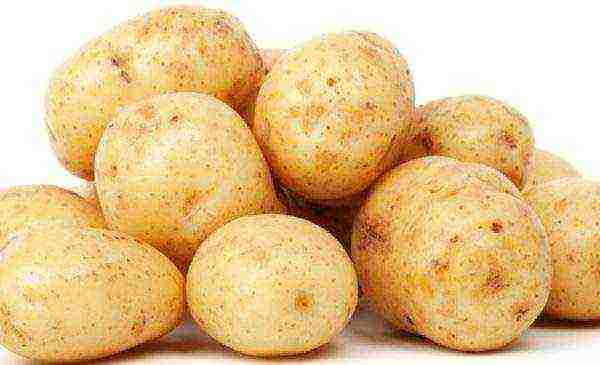
The Triumph variety is distinguished by the high commercial quality of fruits.
-
Sotochka. This variety entered the State Register in 2013, bred in Omsk. Resistant to cancer, but susceptible to golden nematodes. The variety is mid-season, table variety, the maximum yield is 465 c / ha. The skin of the fruit is reticulate, reddish, the pulp is light, yellowish. Potatoes are good for all kinds of dishes.

Sotochka potatoes have high commercial qualities and are characterized by good keeping quality.
-
Lina. A mid-early variety, bred at the Siberian Research Institute of Plant Production and Breeding, Siberian Branch of the Russian Academy of Agricultural Sciences. The cultivar is not new and has already managed to fall in love with many potato growers. Recommended for growing in Krasnoyarsk, Tyumen, Novosibirsk, Omsk, Irkutsk. Its main advantage is its high yield, which in some years reaches 500 centners per hectare. In addition, the Lina variety is characterized by a high starch content - up to 18%. Relatively resistant to nematodes, late blight, tolerates drought and prolonged rains well.
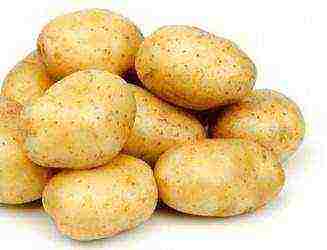
Lina potatoes are well adapted to unfavorable conditions and have a high yield
Video: which potatoes are the most productive
Rating of varieties by taste
The yield per one hundred square meters or hectare is an important characteristic of potatoes, but taste is no less important. To determine the taste characteristics, tubers are steamed without salt. The results can be judged by comparing the following characteristics:
- Looseness - the more starch in the tubers, the looser they are. The starch content of potatoes ranges from 10% (Nevsky) to 25% (Lazar). Vegetables with a high starch content are not only tastier, but also healthier, as they contain more minerals that the body needs.
- Smell - boiled tubers should have a noticeable potato aroma.
- The consistency is hard, soft, watery.
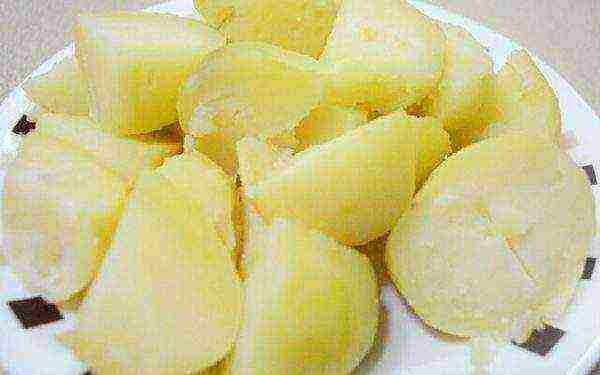
Loose potatoes contain a large amount of starch and other useful substances
The taste of potatoes is a subjective concept. It is determined collectively at tastings held in various organizations related to the study and variety testing of potatoes.
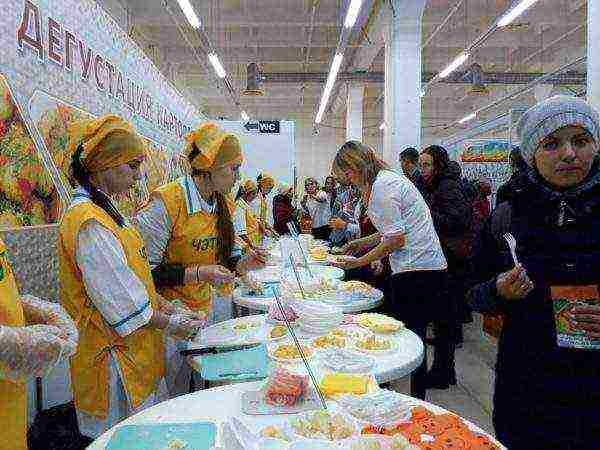
At the tastings, you can evaluate and compare the taste of different varieties of potatoes
In 2016, 10 cultivars were tasted in the Omsk club of potato growers. Agria got the highest score (4.8 out of 5). The rest of the varieties are arranged as follows (in descending order of taste):
- Unique;
- Hostess;
- Knapweed;
- Epic;
- Alyona;
- Scarlet Dawn;
- Adretta;
- Karatop;
- Red Scarlett.
Features of growing potatoes in Siberia
The agricultural technology of Siberian potatoes is somewhat different from the technology of growing this crop in other regions of Russia and the countries of the former USSR. The soil here warms up late, so planting does not begin until May, and in the eastern regions of Siberia - at the end of spring. If potato growers of the middle lane have the opportunity to dig in early potatoes already in June, then in Siberia, meanwhile, shoots are just emerging. None of the techniques, including vernalization, help to noticeably accelerate the appearance of green shoots.
Potatoes can be planted when the ground warms up to a depth of 15 centimeters. The soil temperature should be at least 8 degrees.
A month before planting, tubers are taken out of storage for germination. This technique is very important, since in the conditions of a short northern summer, plants must quickly rise and have time to receive the energy of the sun. Tubers with already appeared sprouts and root buds are planted on the beds.

In Siberia, planting sprouted potatoes is an important condition for obtaining a good harvest.
Planting methods
In Siberia, potatoes are planted in several ways:
- one-line,
- tape,
- comb.
The one-line method is the most common. The tubers are planted in a row at a distance of 25–30 cm from each other, leaving 60–70 cm between the rows.With this planting method, potatoes can be planted shallowly - to a depth of only 10 cm - since hilling will be carried out later.
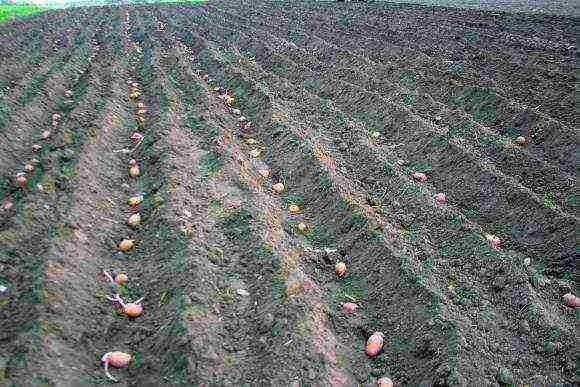
When planting potatoes in a single line, the distance between the rows is 60-70 cm
Tape planting is used for industrial cultivation. The potatoes are planted in two rows. The distance between the rows is 30 cm, the gap between the ribbons is 110 cm. With this method of planting, hilling can be carried out with a tractor, the roots of the plants are not damaged.
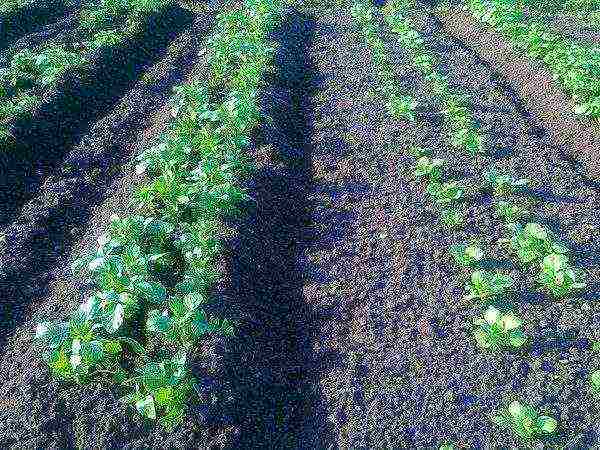
With the strip method, potatoes are planted in double rows
Ridge landing is used in areas where there is a lot of rainfall or groundwater is close to the soil surface. The ridges are artificially raised to a height of 20 cm, leaving 70 cm between the rows. This method of planting allows you to harvest an early harvest on waterlogged and heavy soils.

Potatoes are planted in ridges where water comes close to the soil surface
Watering
The amount of water greatly affects the size and quality of the potato crop. Throughout the growing season, it is necessary to carefully monitor the moisture content of the soil. In the dry season, you have to supply water to the site at least 5 times:
- For the first time, the potatoes are watered 2 weeks after the mass emergence of shoots.
- The second important period is plant budding. The approximate watering rate at this time is about 7 liters of water for each plant.
- If the ground becomes dry at a depth of 7 cm, then the plantings need to be additionally moistened.
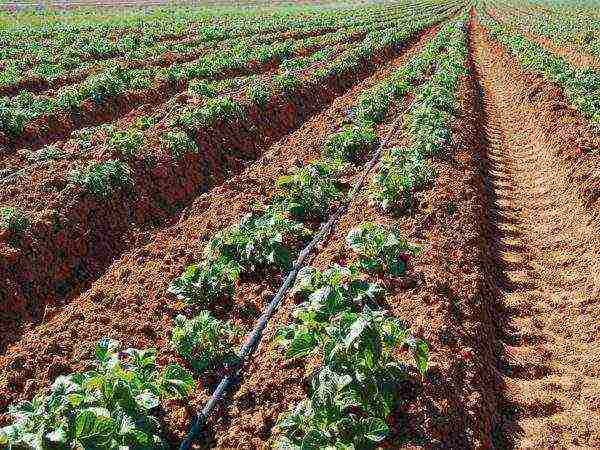
Drip irrigation is the most economical way of watering potatoes, which requires a minimum of physical costs.
The next day after moistening, the soil is loosened, at the same time weeding the aisles and rows.
Hilling potatoes
Even in the south of Siberia in June there are often severe frosts on the soil. It is advisable to mulch rows with not yet emerged potatoes with cut grass or other plant residues. Before the emergence of seedlings, the field is not weeded, so as not to accidentally damage future seedlings.
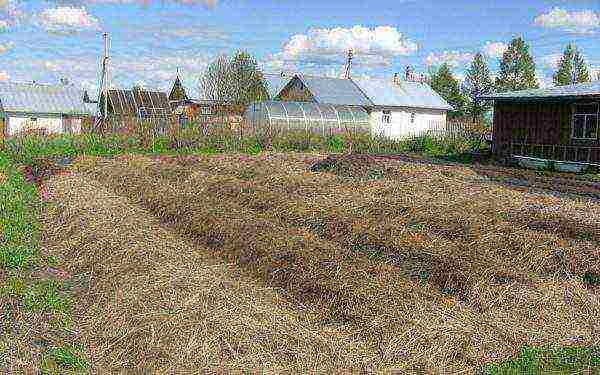
After planting, it is advisable to mulch potato ridges in order to protect the seedlings from frost
While potato seedlings have not yet appeared on the surface, the area can be sprayed with Roundup to destroy perennial and annual weeds.
The first hilling is carried out immediately after germination. It allows you to achieve three goals at once:
- cover the plants with soil to protect them from night frosts;
- rid the plantation of weeds;
- loosen the soil and thus improve the aeration of the roots.
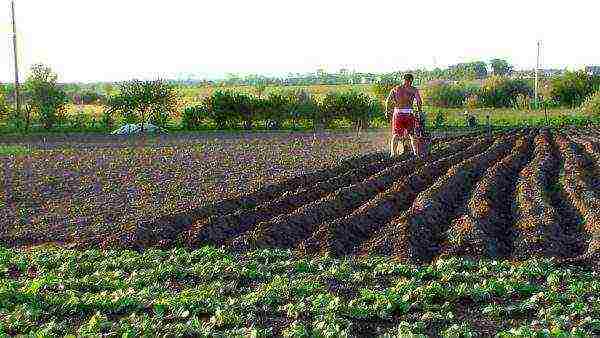
The first hilling of potatoes is carried out immediately after germination
The second hilling can be started when the plants have reached a height of 15–20 cm.
Pest control
In Siberia, potato tubers are harmed by the Colorado potato beetle and wireworm. There is no bear in the region - a pest that annoys potato growers in more southern regions.
They get rid of harmful insects with the help of chemicals, such as:
- Prestige;
- Aktara;
- Force;
- Bankcol;
- Eplace Quantum.
In personal farms, the Colorado potato beetle is harvested by hand.
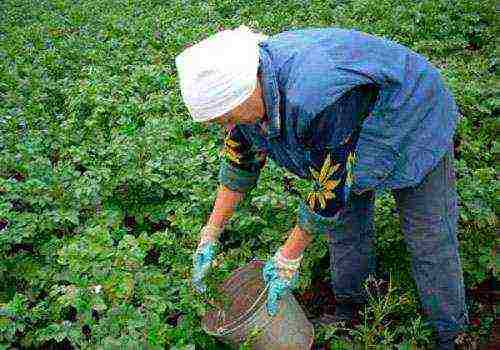
Colorado beetles are harvested by hand in small areas
Photo gallery: preparations for protecting potatoes
Harvest
Early potatoes in Siberia are harvested from mid-August, other varieties - from mid-September to the second week of October. The tubers are dug up when the stems begin to dry out. A week or two before harvesting, the potato tops are mowed to protect the tubers from late blight. This technique also contributes to better storage and transportation of the crop, since after mowing the leaves, the skin on the tubers becomes coarser.
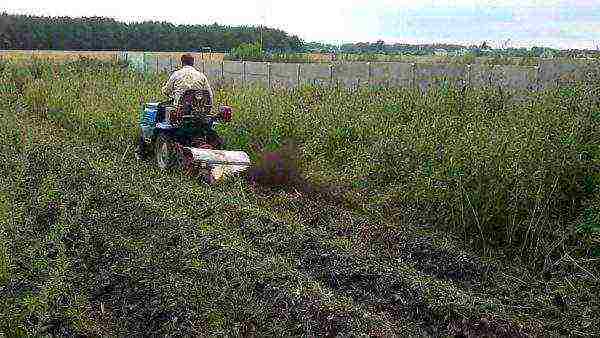
One to two weeks before harvesting, the tops of the potatoes are mowed to protect the tubers from diseases.
Reviews of gardeners
The climate and soil of Siberia are completely suitable for growing potatoes. The culture feels good in this region, shows a high yield (200-300 c / ha, and some varieties - up to 500 c / ha). In Siberia, varieties of mid-early, early and mid-season ripening can be grown.
Rate the article:
(0 votes, average: 0 out of 5)
Growing potatoes for seeds in the Krasnoyarsk Territory
Climatic conditions of the Krasnoyarsk Territory
The climate of the Krasnoyarsk Territory, stretched over a huge distance from north to south, is extremely complex and diverse. The arrival of heat from the sun in the form of direct and scattered radiation is of great importance in the formation of the climate. On the territory of the Krasnoyarsk Territory, the total radiation decreases from south to north. In addition to solar energy, the features of atmospheric circulation are of great importance in the formation of the climate. According to the agroclimatic zoning of Russia, the agricultural part of the Krasnoyarsk Territory belongs to the temperate zone, the cold-temperate sub-zone. An analysis of the natural conditions of the Krasnoyarsk Territory shows that the spring in the agricultural zone is short and dry. Autumn is short with constant low temperatures in September, October, November. Winter with little snow, cold. In most of the territory, stable soil freezing occurs in the first decade of November. The greatest freezing is observed in the steppe zone, where the snow cover is not high. Snow appears at the end of October; in the first half of November, snow cover is established everywhere. In the central and southern regions of the region, the height of the snow cover is 10–20 cm. From the second to the third decade of February, in the forest-steppe and steppe zones, the height of the snow cover decreases, sometimes there are thaws, the snow melts and thickens. The average annual precipitation is 362 mm, of which more than 70% falls during the warm period. The average annual air temperature is - 0.2. The positive average monthly temperature begins from April and is observed until October at all points. The average temperature over the summer months is much lower than many points in the European part of Russia.
Droughts and dry conditions are unfavorable for agriculture. The main grain crop is spring wheat, along with which an appropriate place should be given to the cultivation of barley, oats, peas in relation to corn for silage, annual and perennial grasses, especially legumes, potatoes, root crops and vegetables.
Westerly and south-westerly winds prevail over the territory of the economy. The average annual wind speed is about 3 m / s.
The climate of the territory, where the given economy is located, is conditioned, as sharply continental, with cold long winters and short hot summers. Hail is an unfavorable phenomenon for agriculture. The increase or decrease in the number of hail falls is greatly influenced by hills and mountains, as well as large bodies of water.
Table 4. Meteorological characteristics of the growing season
| Year | May | June | July | August | September | Amount for | |
| vegetation | annual | ||||||
| Average air temperature, С | |||||||
| 2006 | 13 | 27 | 25 | 21 | 12 | 98 | 82 |
| 2007 | 18 | 17 | 29 | 22 | 9 | 95 | 75 |
| 2008 | 13 | 22 | 25 | 19 | 11 | 90 | 66 |
| Average pl. | 14,6 | 22 | 26,3 | 20,7 | 10,7 | 94,3 | 74,3 |
| Precipitation, mm | |||||||
| 2006 | 33 | 40 | 37 | 31 | 40 | 181 | 272 |
| 2007 | 36 | 35 | 43 | 44 | 38 | 196 | 291 |
| 2008 | 37 | 36 | 42 | 43 | 40 | 198 | 282 |
| Average pl. | 35,3 | 37 | 40,7 | 39,3 | 39,3 | 191,7 | 281,7 |
| SCC | |||||||
| 2006 | 0,25 | 0,15 | 0,15 | 0,15 | 0,33 | 0,18 | 0,33 |
| 2007 | 0,2 | 0,21 | 0,15 | 0,2 | 0,42 | 0,21 | 0,39 |
| 2008 | 0,28 | 0,16 | 0,17 | 0,23 | 0,36 | 0,22 | 0,43 |
| Average pl. | 0,24 | 0,17 | 0,15 | 0,19 | 0,37 | 0,20 | 0,38 |
Characteristics of crop varieties
Currently, there are about 4 thousand varieties of potatoes in the world. In the Russian State Register of Breeding Achievements, approved for use in production in 2005, 200 varieties of potatoes are presented. Of these, breeders of Russia have created 121 varieties (more than 60%), Belarus. 15, Ukraine. 3, Holland. 25, Germany. 25, UK. 8, Finland. 1st grade. Thus, varieties of domestic selection form the basis of varietal resources in potato growing in Russia and determine the varietal policy in the industry. The agro-climatic conditions of the main regions of Russia in which potatoes are cultivated are characterized by a variety of soil composition and fertility, the amount and uniformity of precipitation during the growing season, the sum of effective temperatures, frost-free period and other factors.These features largely determine the use by potatoes of the bioclimatic potential of the territories, the degree of risk and the level of yield. For most regions and farms, the correct selection of varieties is of practical importance, taking into account the length of the growing season required for their full ripening. Potato varieties are characterized by varying degrees of disease and pest resistance. Almost all varieties included in the State Register are resistant to a dangerous quarantine disease. potato crayfish. The exception is 9 varieties. Volzhanin, Hybrid VK.1, Ermak improved, Kemerovo, Krasnopolsky, Lorkh, Priobsky, Pink from Miletus and Tulunsky. Basically, these are varieties that have long been included in the State Register, as well as Hybrid VK.1. the only cultivar population, consisting of various genotypes, of which approximately 85% are cancer-resistant.
The second dangerous quarantine target for potatoes is the golden potato nematode. Currently, 16 domestic nematode-resistant varieties are included in the State Register of Breeding Achievements: Almaz, Aspiya, Bezhitskiy, Desnitsa, Zhukovskiy early, Zavorovskiy, Kristall, Lira, Lukyanovskiy, Nayada, Pushkinets, Rozhdestvenskiy, Rossiyanka, Shurminskiy. 2, Malinovka, Krepysh. In the regions of potato cultivation under conditions of high temperatures and in dry years, instead of late blight, Alternaria inflicts harm on potatoes. To combat this pathogen, the same means of chemical protection are used, and an important role belongs to relatively resistant varieties. According to the originators of the varieties, these include: Bronnitsky, Bryansk delicacy, Bryansk red, Spring red, Volzhanin, Golubizna, Lina, Lyubava, Master, Nevsky, Nikulinsky, Pobeda, Reserve, Resource, Skazka, Skoroplodny, Slava Bryansk.
Next, I would like to describe some varieties of potatoes:
Kemerovo.
Bred by clonal selection from the Volzhanin variety by the Kemerovo Regional Agricultural Station. In the State Register since 1958 Mid-early. Dining purpose. The tubers are light. beige. The eyes are of medium depth. The pulp is white. The corolla is white. Productivity 29.35 t / ha. Marketability 86.95%. The mass of the marketable tuber is 100.120 g. Starch content is 13.16%. Good taste and keeping quality. Not resistant to cancer, severely affected by common scab, weakly. late blight and viruses of the mosaic group. Irrigation responsive. Variety value: high yield and marketability of tubers, good taste.
Spark.
Bred by the Ural Research Institute of Agriculture and the Ural Agricultural Institute. In the State Register since 1965. Early. Dining purpose. The tuber is light. beige. The pulp is white. The eyes are small. The corolla is white. Medium to high yield. Marketability 90.92%. The mass of marketable tubers is 90.120 g. Starch content is 13.19%. Fair to good taste. Medium to good preservation in winter. Medium resistant to viral diseases and late blight. Susceptible to rhizoctonia and common scab. Variety value: early ripening, fruitful.
Ermak improved.
Bred by the Siberian Research Institute of Agriculture by clonal selection from the Ermak variety (a clone of the Early Rose variety). In the State Register since 1978. Early. Dining purpose. The tubers are pink. The eyes are small. The pulp is white with red inclusions. Corolla pale red. Violet. Productivity 35.47 t / ha. Marketability 87.92%. The mass of marketable tubers is 90.117 g. Starch content is 10.12%. Good taste and keeping quality. Cancer resistant. It is moderately affected by common scab, fungal, bacterial and viral diseases. Flameproof. responsive to fertilizers and irrigation. Grade value: high taste and safety, heat resistance.
Eugiria.
Bred by the Far Eastern Research Institute of Agriculture. In the State Register since 1994. Medium late. Dining purpose. The tubers are light blue-violet. The eyes are small. The pulp is white. The corolla is white. Productivity 26.30 t / ha. Marketability 80.90%. Marketable tuber weight 85.105 g. Starch content 10.13%. The taste and keeping quality are good. Medium susceptible to late blight, Alternaria, common scab. Variety value: high yield, good taste, keeping quality of tubers.
Agrotechnical measures for the cultivation of potatoes
Placing a crop in a crop rotation
The crop rotations in which potatoes are grown must include the best of their predecessors. In 5–9 full crop rotations, potatoes can make up 12–50%. The higher the saturation of the potato, the shorter the crop rotation. With good soil cultivation and the correct application of fertilizers, potatoes can produce a good harvest in replantings.
The best predecessors for potatoes are winter breads (where they are traditionally sown), annual grain legumes (peas, vetch, lentils, beans, etc.), according to the layer and turnover of the layer of perennial legumes, annual pea-oat mixtures for hay and green fodder, in areas with insufficient moisture under the potatoes leave clean vapors.
Early potatoes are often cultivated as a steaming plant. In this case, sowing of winter crops should be carried out 15-30 days after harvesting potatoes.
Crop rotation schemes where this crop is located.
Crop rotation 1
Field grain-steam cultivation
Average field size - 250 ha
Arable land in the crop rotation - 1252 hectares
Scheme
1. Pure fallow - 260 ha
2. Spring wheat - 228 ha
3. Barley - 244 ha
4. Potatoes - 276 ha
5. Oats - 244 ha
Crop rotation 2
Vegetable forage herb cultivation
Average field size - 253 ha
Arable land in the crop rotation - 1014 hectares
Scheme
1. Annual grasses - 244 ha
2. Cabbage - 250 ha
3. Root crops, corn - 244 hectares
4. Potatoes - 276 ha
Tillage system
One of the main conditions for high yields of potatoes is the creation of a powerful, loose, well aerated and sufficiently moist arable layer.
The main cultivation of the soil for potatoes is deep, often repeated plowing (to a depth of 25–30 cm). Disc or share peeling is carried out before plowing.
Where there was no stubble sowing, fall plowing is carried out immediately after harvesting the previous crop. In autumn, the soil after autumn plowing should not be very compacted and overgrown with weeds.
In such cases, it is necessary to cultivate the field or do deep cultivation with heavy disk tools. All this contributes to a better accumulation of autumn-winter precipitation. In the dry summer-autumn period, when it is impossible to carry out high-quality autumn plowing of the soil, they are limited to disking, and the plowing is transferred to a more favorable time or deep plowing is carried out.
On a fallow field and early plowing in the fall, ridges are cut with a cultivator with three-tiered dumps. The height of the ridges is 30–35 cm. If they cannot be cut in the fall, they are cut in the spring after the spring harrowing and drying of the soil. The soil is preliminarily loosened to a depth of 20–22 cm, with harrows and furrowing.
On the field, where the ridges are cut, they carry out harrowing, mandrel of the ridges for planting. In the summer, hilling is carried out with an increase in the height of the ridges and until the rows close.
Fertilizer system
The dose of food elements is set according to the formula:
D = Up * H * K1 * K2, where
D is the NPK dose for the planned yield of kg⁄ha.
UP - planned yield, kg / ha;
Н - standard NPK costs per 1 centner of main and by-products, kg;
К1 - coefficient of soil nutrient supply;
K2 - correction factor for moisture content in a meter layer of soil.
DN = 69.8 * 0.5 * 0.8 * 1.2 = 33.5 kg⁄ha
DR2O5 = 69.8 * 0.47 * 0.7 * 1.2 = 27.5 kg⁄ha
Dk2 o = 69.8 * 0.42 * 1.1 * 1.2 = 38.7 kg / ha
Table 7. Estimated NPK rates for programmable potato yield
| Culture | Productivity, c / ha | NPK rates, kg / ha | Humus rate, t / ha | ||
| N | P2O5 | K2O | |||
| Seed potatoes | 69,8 | 33,5 | 27,5 | 38,7 | 40 |
Table 8. Methods of fertilizing fertilizers
| Index | The main | Presowing | Ryadkovoye | Top dressing | |
| Terms of introduction | in steam or after harvesting the previous crop for plowing | — | — | 2-3rd decade of June | |
| Humus, tga | 40 | — | — | — | |
| Norms, kg / ha | 30–90 | 20–30 | 7–15 | 2–5 | |
| N | 45 | 20 | 14 | 13,4 | |
| P2O5 | 32,3 | 42,3 | 19,5 | 36,8 | |
| K2O | 30 | 13,5 | 8,5 | — | |
For most zones of Russia, the most effective application for potatoes is 20–40 t / ha of manure, and in the northern regions, on cold soils, manure is applied at higher rates of 60–80 t / ha or more.The manure should be well rotted. Of other organic fertilizers, manure-peat and peat-earthen composts with the addition of phosphorus fertilizers or saturation of peat with ammonia water (20-30 liters per 1 ton of peat), with saturation with phosphorus-potassium and micronutrient fertilizers are applied under potatoes.
Potatoes respond well to green manure and green manure fertilizers. The amount of mineral fertilizers depends on the application of organic fertilizers. For example, nitrogen for potatoes is applied without manure, 30–90 kg, and when applying 20–30 t / ha, the dose is reduced to 20–60 kg / ha. Phosphorus fertilizers without manure are applied and when 20 tons of humus are applied, the doses of RK are reduced to 20–60 kg / ha.
The influence of organic fertilizers begins in the second half of the growing season (budding-flowering phase). In the initial period of growth and development, the need for food in potatoes is provided by mineral rather than organic fertilizers. Fertilizer doses vary from geographic location. In the northern zones or areas equated to them, organic and mineral fertilizers are applied in greater quantities than in the southern ones.
With a tuber yield of 40 t / ha and using high fertilizers (more than 120 kg / ha a.i.), the N: P: K ratio should be approximately: northern zones 1: 1.5: 2.0, and in southern zones 1: 1.35: 1.8.
On sod-podzolic soils, boric, zinc and molybdenum micronutrients are applied under potatoes.
Preparing tubers for planting. It is important that the tubers for planting are healthy from diseases, mechanically intact, having the required size and retaining the characteristics of the given variety.
Tubers are sorted in autumn into three fractions: small (up to 50 g), medium (50–80 g) and large (over 80 g). Tubers weighing up to 30-50 g can be used for seeds, but the highest yield is given by tubers 80-100 g.
After additional bulkhead (removal of diseased tubers) and sorting, tubers are wilted in the spring. During this time, the mass of tubers decreases by 10-15%, enzymatic processes are intensified in the tuber, partial greening occurs, which allows you to get early, friendly shoots. At this time, the eyes begin to wake up, but there are no shoots yet, which is very important for mechanized planting.
After withering, germination of tubers begins if manual planting is used. In diffused light, the tubers germinate for 25–30 days at a temperature of 12–15? C. In this case, the length of the sprout should be no more than 15–20 mm. There are other germination methods.
Calculation of the seeding weight
The norm for tubers is calculated by the formula:
Np = Gopt * Msem, where
Нп - planting rate of tubers kg / ha
Gopt - planting density of tubers pcs / ha
B-mass of one tuber, g
Seeding rate for potatoes in the Krasnoyarsk forest-steppe 0.04-0.06 million pcs / ha
Seed preparation for sowing
Tubers are sorted into fractions (small up to 50 g), (average 50–80 g), (large more than 80 g). After sorting, the tubers are pickled, germinated at a temperature of 12-15 C, the length of seedlings for mechanized planting is no more than 25 mm.
Table 9. Seed preparation for sowing
| Name of works | Dates of the | Tools and machines | Name of drugs and doses |
| Calibration of tubers | 1-2 months before landing | Electric motor
KPS-15B, KPS-5B KPS-25 |
Removal of diseased and defective tubers, isolation of seed
fraction of tubers weighing 50 ... 80 g |
| Pre-germination | Before sowing | On special racks or boxes | Humidity 85-90%,
temperature 9-10 ° С until sprouts 0.5–2 cm |
| Etching
seed tubers |
Before sowing | Electric motor KPS-15B, "Gumatoks S". | Polycarbacin 80% dp - 2.6–2.7 kg / t;
TMTD 80% dp 2.1–2.5 kg / t; Khomycin 80% dp - 0.25-0.5 kg / t Tsineb 80% s.p. Working fluid consumption 70 l per 1 ton of seeds |
Landing
Potatoes are planted when the soil temperature rises to 6-8C. Landing is carried out in a short time. In the southern regions, the tubers are planted in the first half of May, and in the northern regions in the second half of May and finish on June 10.Seed potatoes are planted last.
The semi-ridged surface of an oval shape is obtained when radially curved rails are hooked behind the harrow discs.
In pre-cut ridges, the soil temperature is 2–4? C, therefore, seedlings on the ridges appear 4–6 days earlier.
In terms of the number of stems, commercial crops should be with a density of 180-200 thousand, and seed crops - 220-250 thousand, and up to a maximum of 270 thousand stems per 1 hectare of planting.
Deviations from the established density should not exceed 8%, the planting depth and height of the ridges 2 cm. The uniformity of distribution of tubers in a row is 70%, the number of omissions is not more than 3, "kopecks" (2 tubers in a nest) - small fraction 8%, large 1% ...
Table 10. Main indicators of planting seed potatoes
| Culture | Sowing dates | Sowing methods | Seeding rate, thousand pcs / ha | Sowing depth, cm | Agricultural machines | Sowing quality |
| Potatoes for seeds | 1st half of May - 10 June | Ridge, semi-ridged | 60–80 | 8–12 | SN ‑ 4B, KSM ‑ 4A, KSM ‑ 6A, SPSh ‑ 4–90 (KSM ‑ 4–90), L ‑ 202, L ‑ 201 | Compliance with the seeding rate, planting date. Deviation from the set depth ± 2 cm. |
Crop care
Before germination is carried out in blind 1–3 inter-row cultivation with harrows. The first treatment in 5-7 days. The depth of the first treatment is 10- + cm, the subsequent 6–8 cm, the slopes are loosened to a depth of no more than 3–6 cm. The KON-2.8PM, KRN-4.2T, KNO - 2.8 tools with a set of necessary working tools are used. Before germination, use herbicides such as Zenkor, 70% SP (0.7-1.5 kg / ha). Milling cultivators KFK - 2.8 are effective in weed control; KFO - 3.6.
Table 11. Agrotechnical measures for the care of the crop
| Name of works | Plant growth phases. | Dates of the | S. - x. cars. | Conditions (temperature, wind, humidification, etc.) |
| Pre-emergence two-three-fold loosening - hilling | — | 3-6 days after planting as weeds appear every 5-7 days | MTZ-30 | The soil is loose, the structure in the ridge is fine crumbly, the destruction of 90–95% of weeds |
| Post-emergence treatments: loosening, hilling | From emergence to closing of the tops, high hilling - before closing the tops. | MTZ-30 | The depth of the first is 6–8 cm, the second is 8–10 cm, and the third is 6–8 cm. Avoid damage to shallow-planted tubers. | |
| Aerial spraying against late blight | Prophylactic - budding, the beginning of flowering, destructive - when the first signs of the disease appear, subsequent every 7-10 days (contact drugs) and after 14-15 days - ridomil and other systemic fungicides | aviation | Tsineb 80% (d.p. 2.4 - 3.2 kg / ha), daconil 75% (d.p. 1.8-2.4 kg / ha), ditan - m ‑ 45 80 % (dp 1.2-1.6 kg / ha), 1% Bordeaux liquid, 25% ridomil, systemic fungicide (dp 0.8 kg / ha) mixed with contact ( 2 kg / ha) - 50-100 l / ha with aerial spraying. |
Table 12. System of measures for plant protection
| Culture, sown area | Name of the pest | Multiplicity of treatments | Name of the pesticide or biological product | Working fluid consumption, l / ha | In total, the drug and water are required, kg, l. | Waiting period (interval between treatments) |
| Potatoes for seeds | late blight | Prophylactic - budding, the beginning of flowering, destructive - when the first signs of the disease appear, subsequent every 7-10 days (contact preparations) and after 14-15 days | Tsineb 80% (d.p. 2.4 - 3.2 kg / ha), daconil 75% (d.p. 1.8-2.4 kg / ha), ditan - m ‑ 45 80 % (d.p. 1.2–1.6 kg / ha), 1% Bordeaux liquid, 25% ridomil, systemic fungicide (d.p. 0.8 kg / ha) mixed with contact | 50-100 l / ha for aerial spraying. | 7-10 days |
Harvesting activities
Harvesting of seed plantings begins at the end of the third decade of August, when the daytime air temperature does not drop below 7–80C. The maximum amount of seed fraction is formed in plants 20 days after the end of flowering. Preliminary, 14-15 days before harvesting, you can desiccate plants with magnesium chlorate, copper sulfate, calcium chloride chlorate or Reglon 5-7 days before harvesting by ground or by aviation. The best results are obtained by a combination of mechanical and chemical methods, when the tops are removed mechanically after drying them with desiccants.Depending on the weather, separate, combined harvesting methods or direct combining are used. Potatoes are harvested using serial diggers UKV-2 KSG - 1.4 A or combines KKU-2, KKU-2A. On light soils, the KPK-3 three-row harvester shows good results, which, in comparison with the KKU-2 harvester, allows increasing labor productivity by 68.7%, reducing fuel consumption by 8%, labor costs by 40.7% and operating costs by 22% ... It is economically feasible to carry out work on harvesting potatoes in a group way using harvesting and transport complexes, when 3-4 harvesters are working in the corral.
Table 13
| Name of works | Ripeness phase,% moisture | Dates of the | S.-kh. car | Technological requirements | |
| Leaf desiccation | 10-12 days before cleaning | MTZ-80, ON-400 | |||
| Mowing tops | 1-3 days before cleaning | MTZ ‑ 80, KIR - 1.5, UBD ‑ 3A | Cutting height 10-12 cm | ||
| Harvesting tubers | With the onset of average daily temperatures +2 and the threat of frost -1 - -1.5 | MTZ-80, KKU-2A, SKK-4-1, E-686 | The soil content in the harvest is not more than 1%. Tubers can be injured no more than 5%, injuries 5 mm deep, 10 mm long. | ||
The harvesting of potatoes should be finished no later than September 20–25, since with late harvesting it is hypothermic, poorly stored and suitable only for current consumption.
The spread of diseases in lots of seed potatoes is determined by the method of tuber analysis according to GOST 11856-66. Seed lots in the presence of diseases affected by tubers in them (except for wet rot) no more than 5% and soil impurities up to 20% are stored without sorting in order to avoid their unnecessary injury and re-infection. If the number of diseased tubers and impurities in the potato heap exceeds these norms, the potatoes are placed on ventilated areas, under a canopy, in storages, and after 10-15 days a bulkhead and sorting is organized.
Batches of potatoes infected with late blight, bacterial diseases or with a large number of mechanically damaged tubers should be pickled with formalin after they were laid for storage. To do this, in storage facilities with active ventilation, a solution of 40% w.r. formaldehyde at a dose of 2-3 ml / t is placed in the central air duct or next to the suction nozzle of the fan and fumigated for 6 hours. After one - one and a half months, it can be used for food purposes. Potatoes should be stored in storage facilities with active ventilation at an air flow rate of at least 100–120 m3 / h.
One month before laying the harvest for storage, containers and equipment are disinfected with a formalin solution (1 liter of 40% bw for 39 liters of water for 100–150 m2 of surface). 12-15 days before loading, the storage is whitewashed with freshly slaked lime with the addition of copper sulfate.
When loading the storage, the drop height of tubers should not exceed 30–40 cm, and the TZK-30 boom must be constantly moved in a horizontal direction. For standard potatoes, the height of the embankment can be made up to 3-4 m. The larger and cleaner the tubers, the higher they can be poured. Non-standard tubers and with a large admixture of soil should not be covered above 1.5–2.5 m.
Batches of potatoes harvested in rainy weather must be ventilated for 1-2 days with outside air immediately after laying until the droplet moisture is completely removed. The heap is ventilated around the clock. If the outside air does not provide drying, then it is heated to 12-15 ° C at a relative humidity of 80-90%. The exhaust fans must work constantly, which contributes to the healing of mechanical damage to the tubers.
If potato batches contain diseased tubers, especially those affected by late blight, then during the treatment period it is advisable to have a temperature not higher than 11–13 ° C. Cooling is carried out at night with outside air, the temperature of which is 2–50C lower than in the embankment. At negative temperatures of the outside air, it is mixed with the inside, while the temperature should not be lower than +0.5 ° C.In a healthy heap, the temperature is reduced in 40–45 days; in a heap with diseased tubers, this period is reduced to 15–20 days.
Potatoes are stored at a temperature of 2-3 ° C with a relative humidity of 85-90%. It is most difficult to preserve potatoes in the spring in March, when bud germination begins. For their premature germination in the night and morning cold hours, the heap is ventilated with outside air.
You can grow potatoes in Siberia. Get a high yield - too. Yes, this is a region of risky farming, but risk is a noble cause.
The best potato varieties in Siberia
Siberia is a region with a sharply continental climate. There are long winters, short summers, frost in spring, heavy rainfall in late summer and early autumn. Not the most favorable conditions for growing potatoes. Nevertheless, it is the most common vegetable among gardeners. They are constantly trying new methods, looking for new varieties and achieving good results.
For cultivation in Siberian conditions, a zoned variety is suitable, with good resistance to adverse weather conditions.
Gardeners are guided primarily by the potato yield indicator.
The most productive for Siberia
Harvest Siberian varieties - photo
It must be understood that the maximum yields of these varieties can be achieved only if all technological processes are followed and good care is taken.
For growing potatoes in Siberia, it is very important to get the harvest as early as possible, before the onset of cold weather. Therefore, preference is given to early (80–90 days) and medium early (100–115 days) varieties. Late ones (120-135 days) are not grown in this region - they will not have time to ripen.
The earliest
Early - photo gallery
Early varieties are good because they give a harvest earlier than various potato diseases begin to develop. But their disadvantage is that they are poorly stored, therefore, for long-term storage, you need to choose medium-late varieties. The longer a potato grows, the higher its yield and flavor characteristics.
Frost-resistant elite
Some elite potato varieties that stand out against the general background not only in color, but also in their early ripening period (60–75 days) and, which is very important, frost resistance, can be safely attributed to the best ones for growing in Siberia.
Cranberry Red (Cranberry Red) - oval red tubers have a pleasant aroma and delicate taste. Potato pulp - with pink tints, does not change color during heat treatment. The tubers are smooth with almost no eyes. Used in any form. The variety is resistant to cold weather.
Crenbury Red is cold resistant
Huckleberry Gold (Huckleberry Gold) is distinguished by lilac fruits with a soft creamy pulp. The taste is peculiar. Only suitable for frying and mashed potatoes. Frost-resistant variety.
Hucklebury Gold - frost-resistant potato variety
Huckleberry is an old known super-elite variety of Canadian breeders, also known as Red Cranberry. The dream of many gardeners with dark red smooth fruits that do not change color during heat treatment. Due to its cold resistance, it is grown in Siberia, the Moscow region and the Urals.
Hucklebury - the dream of the gardeners of the Urals and Siberia
These varieties were bred for cultivation in Alaska, therefore, they are suitable for Siberia.
Landing
Planting potatoes in Siberia usually begins in May. In Western Siberia - at the beginning, and in Eastern Siberia - in the middle of the month. This is due to the fact that the climate in the western part is slightly milder. Here, delaying the planting of potatoes for one or two weeks, you risk half of the harvest. Therefore, you need to plant on time. Someone is guided by folk signs - they are waiting for the buds to bloom on the trees. Someone is checking the lunar calendar. But the most important and correct landmark is the soil warmed up at a depth of 10 cm up to +9 degrees.
Growing
Growing potatoes consists of the same stages as in other regions: choosing a place for planting, preparing the soil, preparing seed material, planting, leaving, harvesting.
For growing potatoes, a sunny, level place is definitely determined, without freely walking drafts. It is best if cabbage, carrots or cucumbers grew on the site before it. It is not recommended to grow potatoes in the same place for several years.
The soil is prepared in the fall - fertilizers are applied for digging: manure, peat, humus or mineral fertilizers. In the spring, the soil is fertilized again, dug up and potato planting begins. In Siberia, only sprouted tubers should be planted. To do this, in the spring, at the end of March - early April, the tubers are taken out of storage, the largest and healthiest ones are selected, and they begin to prepare them for planting. For two weeks they are kept in a bright, warm room (+18 degrees), laid out on a flat surface in one layer, periodically turning them over. Then they are transferred to boxes covered with newspaper and kept until sowing in a well-lit warm place (+15 degrees). Thus, by the beginning of May, the tubers will already have strong sprouts. The process of warming up and germinating potatoes usually takes about a month.
It is best to plant several varieties at the same time: different ripening periods and different taste characteristics - you never know which variety will give a good harvest this year.
There are several ways of planting potatoes:
- traditional - rows are made at a distance of 70 cm from each other, in a row the distance between tubers is 30 cm. When hilling, the root system of the plant is damaged.
- tape - there is an alternation: 2 rows at a distance of 30 cm, then two rows at a distance of 110 cm from each other. Very good reviews from gardeners.
- ridge - tubers are laid in formed ridges about 30 cm high at a distance of 30 cm from each other. The distance between rows with ridges is 70–90 cm. Suitable for areas with high humidity and areas with high groundwater. On dry soils, potatoes in the ridges often die.
Potatoes are planted only in warm soil.
The basic rules for planting and caring for potatoes are simple:
- The planting depth of potatoes varies from 6 to 15 cm, depending on the type of soil and the size of the tubers.
- To obtain high yields, it is important to observe the planting scheme - 30 * 65 cm. With more frequent plantings, the plants interfere with each other and form tubers poorly.
- Fertilizers are applied to the hole in the form of ash, onion or garlic husks.
- To get rid of weeds, you need to loosen the soil twice: before the first shoots appear and when the plants rise 15 cm.
- Water the potatoes at least three times during the entire growing period: immediately, after germination, at the beginning and at the end of flowering.
- Drying of the tops is a sign of the ripeness of the potato. Two weeks before harvesting, the tops are mowed, thereby allowing the tubers to ripen and the skin to thicken.
How to get a high yield
You can get a high yield of potatoes in Siberia in different ways.
Growing in a greenhouse
For cultivation in a greenhouse, tubers begin to be prepared as early as November. When sprouts appear, the potatoes are transferred to boxes with wet sawdust or peat, and taken out to a heated greenhouse. When the time comes for planting, the tubers will already have strong sprouts and roots. The holes are dug according to the scheme 70 * 25 cm, 8 cm deep. A layer of peat or humus must be laid on the bottom, tubers on top, and all this is sprinkled with a layer of earth. There is no need to water the plantings, otherwise you will create an excess of moisture and the tubers will rot. When seedlings appear and the soil dries up, then you can water the potatoes for the first time. During the period of growth, flowering and formation of tubers, the humidity in the greenhouse should be at least 80-100 percent. The air temperature must be maintained at about +23 degrees. During the period of mass formation of tubers, it should be slightly lowered to +19 degrees. The yield in the greenhouse reaches 350 kg per hundred square meters, and it is not exposed to diseases and pest attacks. Ideal for growing potatoes.
A greenhouse is an ideal place for growing potatoes
Greenhouse
If your greenhouse is occupied by tomatoes, cucumbers or other crops, and there is absolutely no room for potatoes in it, creating a greenhouse will help you. Plant the potatoes in the beds, set the arches, stretch the film, pressing it to the ground and the greenhouse is ready. The film retains heat well, but does not allow air to pass through. Therefore, in good weather, it will need to be opened for airing, weeding, watering and feeding the plants. The greenhouse must be closed at night. Thanks to the created conditions, you will get the harvest ahead of time.
The greenhouse retains heat well
High beds
Since the soil in Siberia heats up for a very long time, you can apply the method of growing potatoes in high beds. Since autumn, they are formed with a height of about half a meter with the help of hay, soil and manure. In these beds, potatoes can be planted earlier than in open ground for two weeks. To accelerate the heating of the soil, the following method is often used: spill with abundant hot water and cover with a film. After the ground warms up, tubers are laid in it. It is better to cover planting before the frost leaves.
Tall beds allow you to plant potatoes earlier
Chinese method
The essence of the Chinese method is as follows: in the fall, you need to dig a trench 50 cm deep, make three holes 70 * 70 cm in it, about half a meter deep, at a distance of 25 cm from each other. At the bottom of the pit, organic matter is placed in the form of grass, leaves, food waste, hay, and ash (2-3 glasses) is added.
In the spring, when the soil warms up to +7 degrees, half a bucket of humus is poured onto the bottom of each pit, three potatoes are laid and sprinkled with 10 cm of earth. Before planting, the potatoes are prepared: a cross-section is made in the middle of the tuber, so that an untouched jumper 1 cm wide remains in the center. The plantings look like a trench with mounds that must be mulched with straw.
As the potatoes grow, it will be necessary to periodically fill up the soil and fertilize with bird droppings diluted in water, in a ratio of 20: 1, respectively. Water the trenches - as the soil dries up, during hot periods - at least 1 time per week.
When the trench is completely filled with earth, you need to let the plant rise to a height of 30 cm, then bend it to the ground, dig in and tear off the lower leaves. As they grow, the bushes continue to be covered with earth and sprayed, the flowers are removed.
When planting potatoes at the end of April, in July, you can harvest the first crop: up to 16 tubers weighing 1.7 kg from one mound. By autumn, the yield rises to 24 kg from one planted tuber.
Any potato variety suitable for your soil type and climatic conditions is suitable for growing. According to gardeners' reviews, varieties such as Karatop, Lyubava, Rosara, Scarlet have shown themselves well.
Growing potatoes by the Chinese method video
Under the straw
Recently, the method of growing potatoes under straw has been widely advertised. There are two planting options: potatoes are buried in the ground or laid on the surface of the ground, and covered with a 20 cm layer of straw or hay on top. It is believed that this method is suitable for lazy people, since it does not require special care.
Advantages and disadvantages of growing potatoes under straw table
The potatoes are warm under the straw
By choosing the right variety and method of growing potatoes, even in Siberia, gardeners get high yields.
Rate the article:
(1 vote, average: 4 out of 5)
Potatoes, varieties of Siberian selection
Varieties included in the State Register of 2015
® 9705810 Antonina Originator and patentee of GNU SibNIISHiT SO RAAS, GNU VNII Potato Farming named after V.I. A.G. Lorkha. Early ripe, canteen. The plant is tall, leaf type, semi-erect. Medium to large leaf, intermediate, green. The waviness of the edge is medium. Corolla medium to large, white.The tuber is oval with eyes of medium depth. The peel is slightly rough, yellow. The pulp is light yellow. The mass of the marketable tuber is 104 - 153 g. The starch content is 15.9 - 19.4%. The taste is good. Keeping quality 95%. Resistant to the causative agent of potato cancer, susceptible to golden potato cyst nematode. Moderately susceptible on tops and tubers to the causative agent of late blight.
® 8756999 Aramis Originator: Krasnoyarsk State Agrarian University. The bush is tall, erect, 4-5 stems, the leaf is dark green, dull, the flowering is weak, of medium duration, the buds are red-violet. Mid-season, table. The growing season is 80-88 days. The tubers are large, oval, slightly flattened, weighing 156-171 grams. The color of the tuber is yellow, the eyes are superficial pink, the flesh is light yellow, not darkening. The variety has a high market value - 87.5-89.1%, the Lin standard has 70.8-71.9%. The yield is 156.5-230.6 c / ha, with a guaranteed increase of 51.7 c / ha. Possesses good taste, starch content 13.7-15.0%. It is in great demand among the population. According to the originator, it is resistant to viral diseases, cancer, golden potato cyst nematode, moderately resistant to late blight.
® 9809935 Borus - 2 Originator and patentee of the State Scientific Institution Scientific Research Institute of the AP of Khakassia. Mid-early, canteen. Plant from very low to low, intermediate type, semi-erect. Medium to large leaf, intermediate to open, green. The waviness of the edge is medium. Corolla medium to large, red-violet. The tuber is oval with eyes of medium depth. The peel is slightly rough, red. The pulp is creamy. The mass of the commercial tuber is 100 -139 g. The starch content is 13.3 - 14.9%. The taste is good. Marketability 84 -91%. Keeping quality 89%. Resistant to the causative agent of potato cancer, susceptible to golden potato cyst nematode. Susceptible to tops and moderately susceptible to tubers to the causative agent of late blight.
® 8954332 Kemerovo resident Originator and patentee: State Scientific Institution Kemerovo Research Institute of Agriculture. Medium early, for dining purposes. The plant is tall, intermediate type, semi-erect. The leaf is medium sized, open, green to dark green. The waviness of the edge is strong. The corolla is small. The intensity of the anthocyanin coloration of the inner side is absent or very weak. The average yield is 270.2 c / ha, 24.2 c / ha higher than Lin's standard, a guaranteed increase of +2.0 c / ha. The maximum yield of 364 c / ha was obtained at the Shushensky GSU in 2011. The tuber is oval-rounded with an average depth of eyes. The rind and flesh are yellow. Tuber weight 111-135 g. Starch content 13.1-15.0%, reducing sugars 0.39%, dry matter 22.0-23.4%. The taste is good and excellent. Marketability 88%, at the standard level. Resistant to the causative agent of potato cancer, golden potato cyst nematode.
® 9200991 Krasnoyarsk early Originator Krasnoyarsk State Agrarian University, State Scientific Research Institute of Potato Farming named after A.G. Lorkha. Early ripe, canteen. The bush is tall, compact, numerous stems, slightly leafy, the leaf is dark green, of medium size, flowering is medium, long, berry formation is rare. Tubers are yellow, oval with a blunt top and a flat stolon track. The peel is smooth, the eyes are numerous, medium-deep, the flesh is white, creamy. The mass of the marketable tuber is 95 - 143 g. The starch content is 12.5 - 17.9%. The taste is excellent. Keeping quality 87 - 94%. It is resistant to cancer, strongly affected by late blight, susceptible to damage by macrosporiosis and rhizoctonia, moderately affected by tuber rot during storage.
® 9464039 Kuznechanka Originator and patentee of the State Scientific Institution Kemerovo Research Institute of Agriculture. Mid-early, dining-style. The plant is of an intermediate type, semi-erect. The leaf is medium sized, closed, green. The waviness of the edge is medium. The corolla is large. The intensity of the anthocyanin coloration of the inner side of the corolla is medium; the proportion of blue is absent or very small.The maximum yield of 1049 c / ha was obtained in 2008 at the Sukhobuzimskiy GSU. The tuber is rounded with eyes of medium depth. The peel is red. The pulp is creamy. The mass of the marketable tuber is 104 - 150 g. The starch content is 12.3 - 16.2%. The taste is good. Marketability 76 - 97%. Keeping quality 95%. Resistant to the causative agent of potato cancer. Susceptible to golden potato cyst nematode.
® 9602534 Lina Originator and patentee of GNU SibNIIRS SO RAAS. Medium early, table, suitable for the production of chips. The bush is upright, intermediate, high. Stems are weakly branched, green, medium-leafy, round in cross section. The leaf is of medium size, medium dissected, light green, slightly pubescent, with weak venation, matte. Abundant flowering, long lasting. The inflorescence is compact. The corolla is white, of medium size, with narrow lobes, with well-developed cusps, the adhesion line is smooth. Berry formation is rare. The tuber is oval, with a blunt apex. The peel is smooth, yellow. The eyes are few in number, medium-deep. The pulp is white. The mass of the commercial tuber is 105 - 250 g. The starch content is 11.2 - 18.5%. The taste is good. Marketability 78 - 99%. Resistant to potato cancer, susceptible to potato golden nematode, tops and tubers resistant to all tested late blight isolates.
® 9908342 Lyubava Originator of the State Scientific Institution Kemerovo Research Institute of Agriculture, State Scientific Research Institute of the Potato Farming named after V.I. A.G. Lorkha, patentee of the State Scientific Institution Kemerovo Research Institute of Agriculture, State Scientific Research Institute of the Potato Economy named after V.I. A.G. Lorkha. Early ripe, canteen. Intermediate type, semi-upright. The leaf is small, open, the leaf is small, the waviness of the edge is weak, the corolla is medium in size, red-violet. The tuber is oval-rounded with eyes of medium depth. The skin is red, medium to coarse. The pulp is white. The mass of the marketable tuber is 109 - 210 g. The starch content is 11.2 - 16.9%. Marketability 80 - 98%. Good taste. Susceptible to golden potato cyst nematode, resistant to the causative agent of potato cancer, susceptible to tops and moderately resistant to the causative agent of late blight in tubers.
® 9608800 Nakra Originator and patent holder GNU SibNIISHiT SO RAAS, GNU VNII Potato Farming named after V.I. A.G. Lorkha, State Scientific Institution Kemerovo Research Institute of Agriculture. Mid-season, versatile. Suitable for cooking crispy potatoes. The plant is tall, erect, medium-sized leaf. The corolla is large, red-violet. The output of marketable products is 80 - 94%. The tuber is oval, the eyes are of medium depth, the peel is red, the flesh is light yellow. Tuber weight 94 - 164 g. The taste is good and excellent. Starch content 16.2 - 19.9%. Keeping quality 81 - 93%. Resistant to potato cancer, susceptible to golden potato nematode, moderately susceptible to golden potato nematode, moderately susceptible to late blight pathogen in tops and tubers.
® 7805632 Nevsky The originator is Vsevolzhskaya Breeding Station CJSC, Sakhalin Research Institute of Plant Development, Sakhalin Research Institute of Agriculture, Soybean Research Institute, Slavyanka-M LLC, Tatar Research Institute of Agriculture, Ural Research Institute of Agriculture, patent holder of Vsevolzhskaya Breeding Station CJSC. Mid-early, canteen. The bush is erect, compact, low, the stems are strongly leafy, the leaf is light green, the flowering is abundant, short-term, the corolla is white, the formation of berries is rare, the tubers are round and oval, with a flat stolon trace. The peel is white, smooth, the eyes are few, small, pink, the flesh is white, not darkening when cut. Marketable tuber weight 86 - 113 g Marketability 92 - 96%. Starch content 12 - 17%. The taste is satisfactory. Keeping quality is good. Resistant to cancer. Weakly susceptible to late blight. Moderately resistant to scab.
® 9462333 ROSARA Originator SAKA PFLANZENZUCHT GBR. Medium early, universal use. Semi-spreading bush. Corolla is red-violet. The tuber is oblong - oval with a red, smooth skin and yellow pulp. The eyes are small. Forms a harvest together. The average yield over the years of testing was 311 c / ha.The maximum yield of 477 c / ha was obtained in 2011 at the Sukhobuzimskiy GSU. Average tuber weight 134 g. Starch content 11.4%. The taste is good. Marketability 86.1%. Resistant to golden potato cyst nematode.
® 9610445 Sarma Originator of FGOU VPO Irkutsk State Agricultural Academy. Medium early, for dining purposes. The plant is of medium height, stem type, erect. The leaf is medium-sized, open, green. The waviness of the edge is medium. Corolla is medium to large in size, the intensity of anthocyanin coloration on the inner side is absent or very weak. The maximum yield is 906 c / ha at the Sukhobuzimskiy GSU. The tuber is oval-rounded with deep eyes. The peel is yellow. The pulp is yellow. The mass of the marketable tuber is 96 - 168 g. The starch content is 13.3 - 15.8%. The taste is good and excellent. Marketability 80 - 97%. Keeping quality 88%. Resistant to the causative agent of potato cancer, susceptible to golden potato cyst nematode.
® 9464069 Sappho Originator of the GNU Siberian Research Institute of the RS SO RAAS. Medium early, for dining purposes. Leaf type plant, semi-erect. Medium leaf, intermediate type, green. The waviness of the edge is medium. The corolla is large. The intensity of anthocyanin coloration of the inner side of the corolla is absent or very weak, the proportion of blue is absent or very small. The maximum yield is 536 c / ha. The tuber is oval, with small eyes. The peel is light beige. The pulp is creamy. The mass of the commercial tuber is 111 - 232 g. The starch content is 10.9 - 16.7%. The taste is good. Marketability 82 - 96%. Keeping quality 82%. Resistant to the causative agent of potato cancer, golden potato cyst nematode. Resistant to wrinkled and banded mosaics, leaf curling.
® 9052449 NORTH Originator and patentee of the State Scientific Institution Yakutsk Research Institute of Agriculture. Early maturing, vegetation period 73 - 80 days. Dining purpose. The tuber is oval-rounded. The peel is yellow. The pulp is light yellow. The average yield over the years of testing was 245.6 c / ha. The maximum yield of 467 c / ha was obtained in 2011 at the Shushensky GSU. Average tuber weight 123 g. Starch content 14.1%. The taste is good and excellent. Resistant to golden cyst nematode.
® 9154424 TANAI Originator and patentee of the State Scientific Institution Kemerovo Research Institute of Agriculture. Medium early, for dining purposes. The plant is of an intermediate type, semi-erect. The leaf is large, intermediate, from green to dark green. Medium to strong wavy edges. Corolla small to medium in size. The intensity of anthocyanin coloration on the inner side is absent or very weak. The average yield for the years of testing is 374.5 c / ha. The maximum yield of 632 c / ha was obtained in 2010 at the Krasnoyarsk State Administration of Management. The tuber is oval with small eyes. The rind and flesh are yellow. The mass of the marketable tuber is 127 g. The starch content is 10.7-15.0%. The taste is good. Marketability 84.8%. Keeping quality 92%. Resistant to the causative agent of potato cancer and golden potato cyst nematode. According to the originator, it is moderately resistant to late blight pathogen, wrinkled mosaic, banded mosaic and leaf twisting.
® 9610178 Tuleevsky Originator and patentee of the State Scientific Institution Kemerovo Research Institute of Agriculture, State Scientific Research Institute of Potato Farming named after V.I. A.G. Lorkha. Mid-season, table. Medium height. Intermediate type, semi-upright. Medium-sized, intermediate to open leaf, dark green. The waviness of the edge is weak. The corolla is very large and white. The tuber is long with very small eyes. The peel is slightly rough, yellow. The pulp is yellow. The mass of the marketable tuber is 122 - 270 g. The starch content is 13.7 - 16.8%. The taste is good and excellent. Marketability 88 - 99%. Keeping quality 90%. Resistant to the causative agent of potato cancer, susceptible to golden potato cyst nematode. Moderately resistant to tops and moderately susceptible to tubers to the causative agent of late blight.
® 9702229 Felox Originator SAKA PFLANZENZUCHT GBR, CJSC 'OCTOBERSKOE', LLC FH 'SEDEK' Early maturing, for dining purposes. The plant is erect. The leaf is green to dark green. The leaf is medium to large, glossy. The anthocyanin color of the bud is weak. Corolla medium to large, reddish purple. The marketable yield is 222.5 c / ha, for the Krasnoyarsk early standard - 177.6 c / ha, the guaranteed increase was 44.9 c / ha. The maximum yield is 293 c / ha at the Krasnoturanskiy GSU. The tuber is elongated-oval, with a yellow skin and light yellow pulp. The mass of marketable tuber is 106-155 g. Biochemical indicators at the level of the standard variety Krasnoyarskiy Early. The taste is excellent. Marketability 80.3%. Resistant to the causative agent of potato cancer, golden potato cyst nematode, has an average resistance to late blight.
® 9464177 Hostess Originator and patentee of the State Scientific Institution Siberian Research Institute of Agriculture. Mid-season, versatile, suitable for processing into crispy potatoes. The plant is tall, intermediate type, semi-erect. The leaf is large, open, dark green. The waviness of the edge is strong. The anthocyanin color of the bud is weak. The tuber is oval-rounded with small eyes. The peel is red. The pulp is creamy. The mass of the marketable tuber is 101 - 179 g. The starch content is 14 - 21.8%. The taste is good and excellent. Marketability 87 - 97%. Keeping quality 95%. Resistant to the causative agent of potato cancer. Resistant to golden potato cyst nematode.
